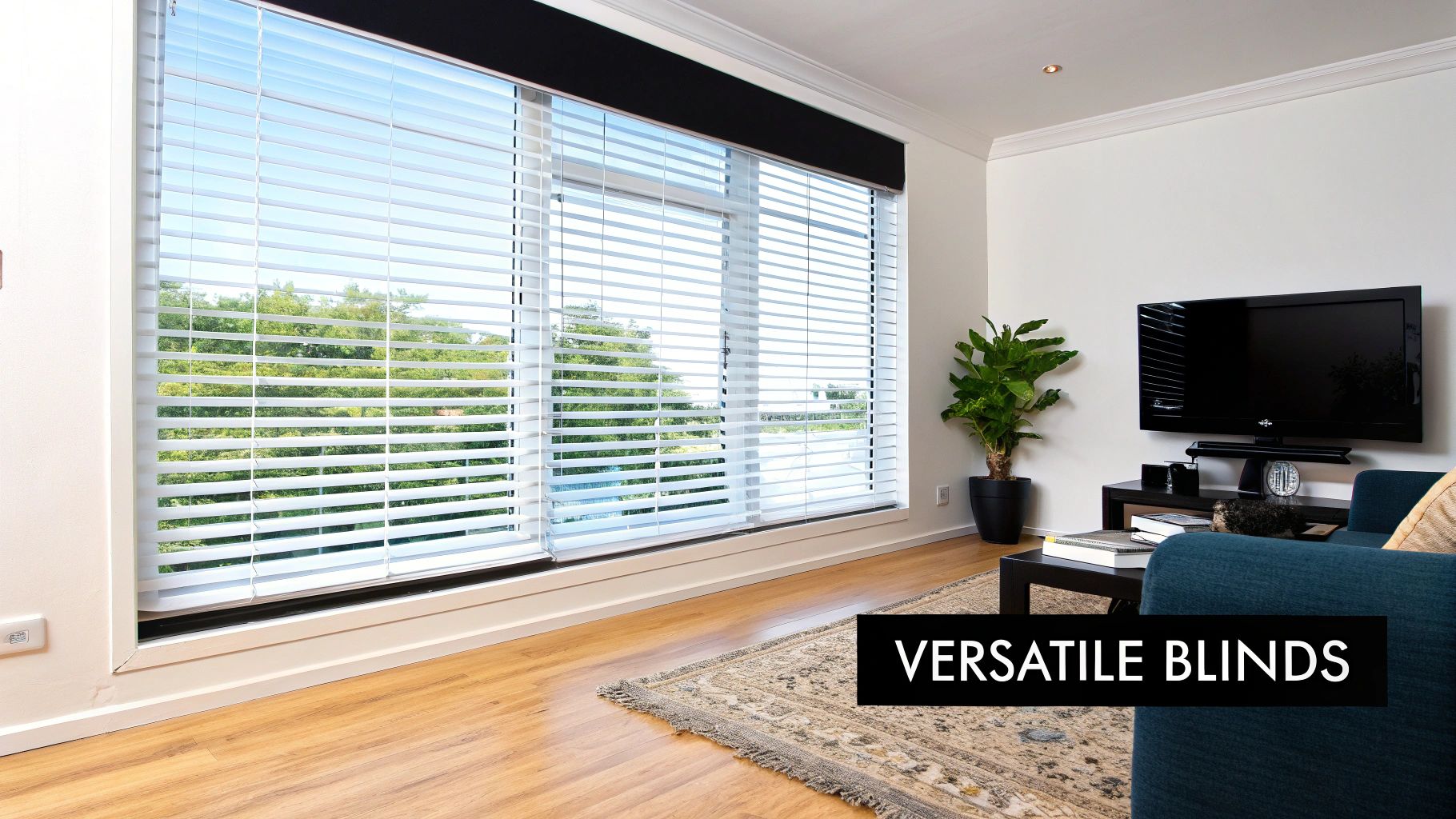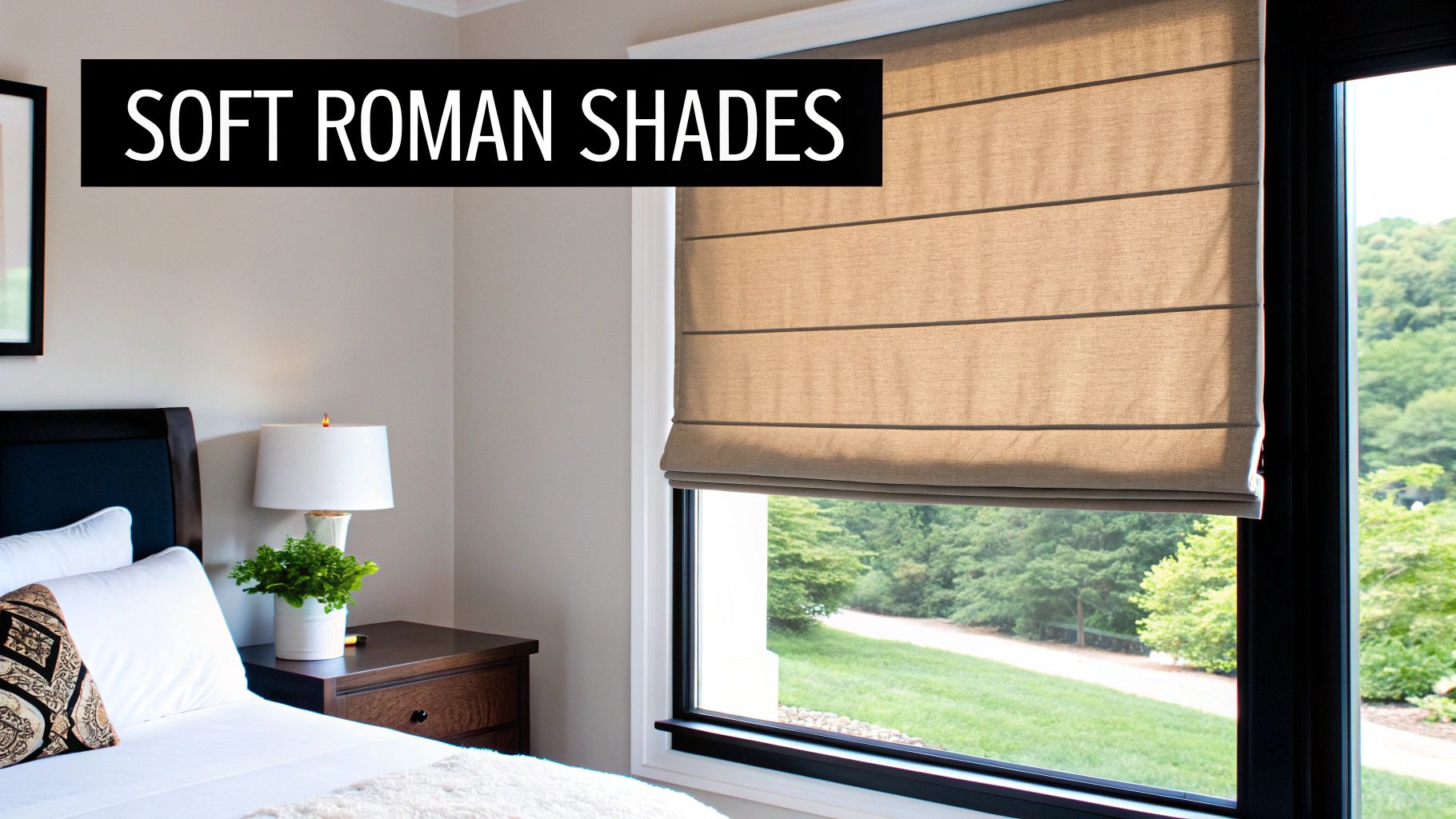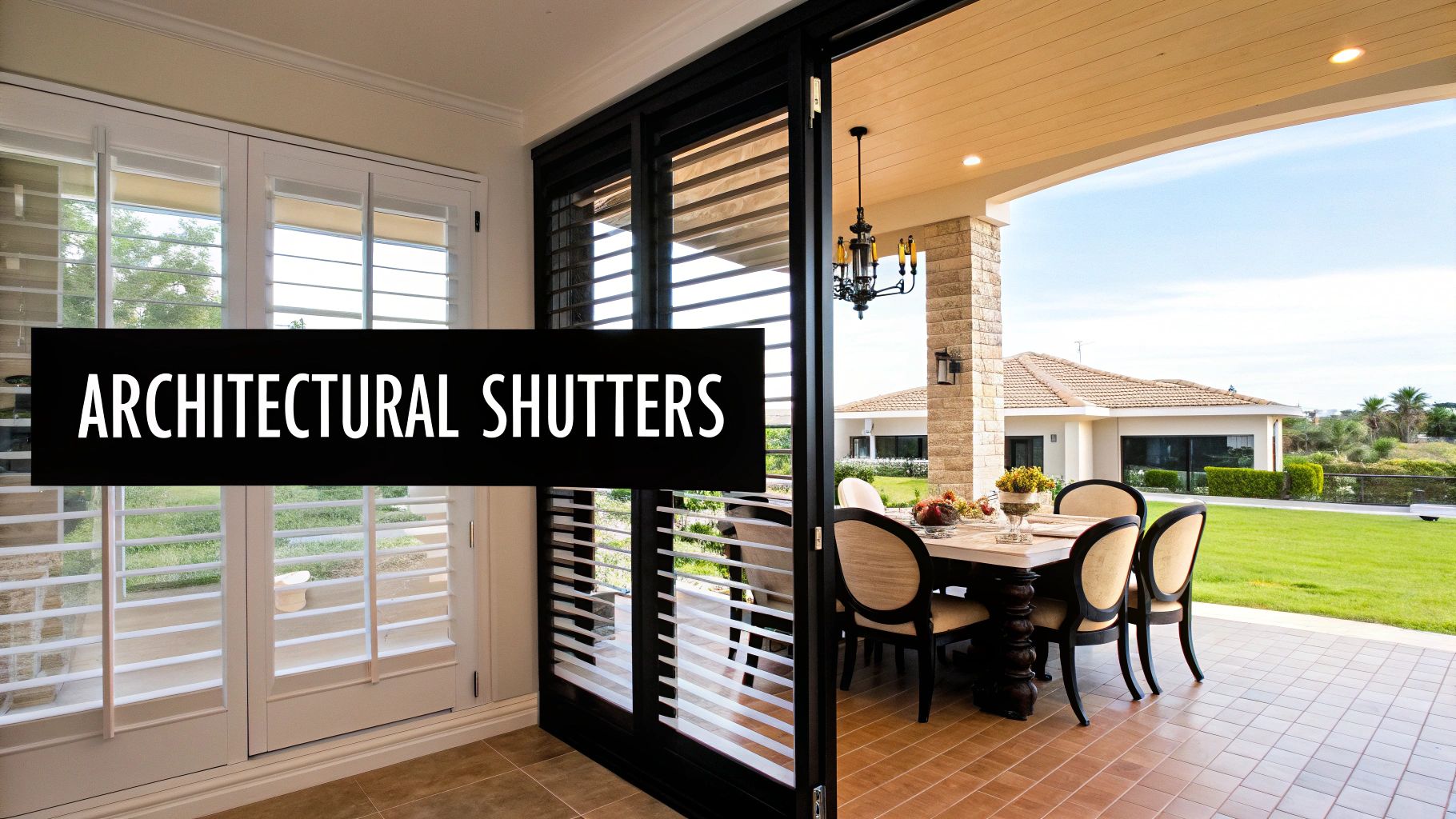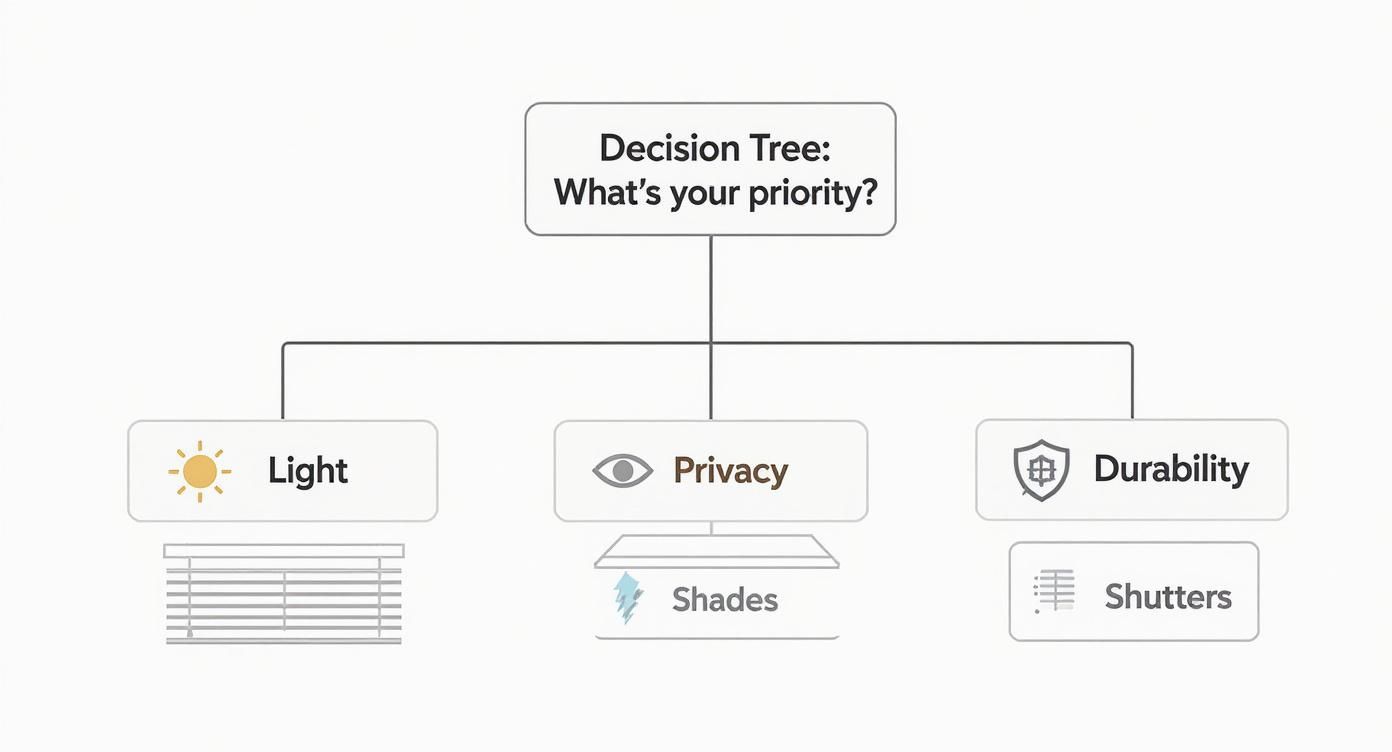
16 Stylish Alternatives to Curtains for a Modern Home in 2024
Are you tired of the same old curtains? It’s a common feeling. Many homeowners are looking for a sleek, modern alternative to curtains that offers better control over light and privacy. From versatile blinds to elegant shades and architectural shutters, these options provide a cleaner look that's often much easier to maintain than traditional drapes. They are the go-to choice for contemporary homes for a reason.
Ready to explore window treatments beyond traditional drapes? You're in good company. This guide will walk you through the best modern curtain alternatives to help you find the perfect match for your home, lifestyle, and budget.
Table of Contents
- Why Consider an Alternative to Curtains?
- Blinds: A Versatile and Practical Curtain Alternative
- Shades: The Soft and Stylish Window Solution
- Shutters and Films: Innovative Structural Options
- How to Choose the Right Alternative for Any Room
- A Practical Guide to Measuring and Installation
- Frequently Asked Questions About Curtain Alternatives
Why Consider an Alternative to Curtains?
Homeowners are increasingly choosing curtain alternatives to achieve a clean, minimalist aesthetic, gain precise control over sunlight, and simplify their cleaning routines. This shift isn't just a fleeting trend; it reflects a desire for home solutions that are functional, stylish, and efficient.
The global market for curtains and window blinds is projected to surpass $57 billion by 2034, with blinds and shades making up a significant portion of that growth. This data shows a clear preference for modern, practical window treatments over traditional drapery.
This guide will compare the top three categories:
- Versatile Blinds: Known for adjustable slats that offer pinpoint light control.
- Elegant Shades: Fabric-based solutions that provide a soft look and excellent insulation.
- Architectural Shutters: Durable, built-in options that can increase your home's value.
For an overview of how to get started, check out our guide on how to choose window treatments.
Blinds: A Versatile and Practical Curtain Alternative
When you’re looking for a functional and stylish alternative to curtains, blinds are consistently one of the top choices. Their magic lies in precision. Unlike fabric drapes that are either open or closed, blinds offer nuanced control over both light and privacy. You can tilt the slats to redirect sunlight, angle them for privacy while enjoying the view, or raise them completely for an unobstructed window.
This incredible level of control makes blinds a practical pick for nearly any room in the house. From the classic horizontal slats of Venetian blinds to the sleek lines of vertical blinds for sliding doors, there's a style to fit every window.

Exploring Different Blind Materials
The material you choose impacts both the look and performance of your blinds. Each option brings specific benefits designed for different environments. Understanding these differences is key to picking the perfect fit.
Here’s a quick breakdown of common materials:
- Real Wood: Adds a timeless, warm look to living rooms, studies, and bedrooms. Wood is lightweight but can be sensitive to high humidity.
- Faux Wood: These are the durable, moisture-resistant champions. Faux wood is the ideal alternative to curtains for high-humidity spots like bathrooms and kitchens, offering the look of real wood without warping concerns.
- Aluminum: Sleek, lightweight, and available in a massive range of colors. Aluminum blinds are a cost-effective choice for a modern, minimalist vibe and are incredibly easy to clean.
- Vinyl: The most budget-friendly option. Vinyl blinds are durable, simple to maintain, and resist moisture well, making them a no-fuss, practical solution.
Deciding between real and faux wood can be tough. If you're stuck, our detailed guide on wood blinds or faux wood blinds can help you weigh the pros and cons.
Key Styles: Venetian vs. Vertical
Beyond materials, the orientation of the slats—horizontal or vertical—defines the blind's style and function. Venetian blinds, with their horizontal slats, are the most common style. They work beautifully on standard-sized windows, offering a classic, clean look and amazing light control.
Vertical blinds feature slats that run top to bottom. This design makes them the go-to solution for large windows and sliding glass doors, where horizontal blinds would be heavy and cumbersome. They draw open to the side like drapes, making them easy to operate over doorways.
Expert Insight: For rooms where you need to adjust natural light throughout the day, blinds provide a level of granular control that few other window treatments can match. This is particularly useful in home offices to reduce screen glare or in living rooms to redirect afternoon sun.
Shades: The Soft and Stylish Window Solution
When you love the softness of fabric but want a cleaner, more modern look, window shades are the perfect alternative to curtains. They offer the warmth of drapes in a single, streamlined piece of fabric that rolls, folds, or gathers. This simple design takes up less visual space, making rooms feel more open while providing fantastic light control and privacy.
The growing popularity of shades is reflected in market trends. The global window shade market is on track to hit USD 7.76 billion by 2032, showing just how many homeowners are choosing these functional, beautiful window treatments.

Popular Types of Window Shades
Shades come in several distinct styles, each bringing something different to the table. Understanding these differences is the key to finding the right fit for your home's aesthetic and functional needs.
Here are the top styles people choose:
- Roller Shades: The definition of modern simplicity. A single panel of fabric wraps around a roller, disappearing neatly when raised. They’re perfect for a minimalist look and come in everything from sheer to total blackout materials.
- Roman Shades: For a touch of classic elegance, Roman shades are tough to beat. They are made from fabric that stacks into soft, even folds when raised, creating a look that feels both structured and luxurious.
- Cellular (Honeycomb) Shades: The undisputed champions of energy efficiency. Their unique honeycomb pockets trap air, creating an insulating barrier against heat and cold that can help lower utility bills.
- Woven Wood Shades: Want to bring a bit of nature indoors? Made from materials like bamboo, reeds, and grasses, these shades add organic warmth and a relaxed, earthy vibe.
- Solar Shades: Engineered to reduce glare and block harmful UV rays, these shades protect your furniture and eyes while preserving your view outside. They are an ideal choice for sun-drenched rooms and home offices. For more info, see this guide on the best solar screens for windows.
Functional Benefits for Modern Homes
Beyond looking great, different shades offer real functional benefits. A blackout roller shade is a game-changer in a bedroom or media room, providing complete darkness for better sleep or the perfect movie night. To help you sort it out, we've put together a full guide on light-filtering vs. blackout shades that breaks down the pros and cons.
Cellular shades are a smart investment for anyone focused on sustainability. Their insulating qualities don't just help with temperature; they also dampen outside noise, creating a more peaceful home. According to the U.S. Department of Energy, cellular shades can reduce heat loss through windows by 40% or more, translating to about 20% savings on heating and cooling costs.
With their clean lines and diverse materials, shades offer a sophisticated yet understated alternative to curtains that can adapt to almost any interior design style.
Shutters and Films: Innovative Structural Options
Beyond fabrics and slats, you'll find architectural and permanent alternatives to curtains. Shutters and window films integrate directly with your window's structure, offering a sleek, built-in look that’s both modern and incredibly functional. If you want a durable, low-maintenance solution that enhances your home’s character, this is where you should look.
Plantation shutters, for instance, feel less like a window covering and more like a long-term home upgrade. Their solid construction and classic design add an architectural elegance that can genuinely increase your property value.

The Timeless Appeal of Plantation Shutters
Plantation shutters are recognized by their wide louvers, typically ranging from 2.5 to 4.5 inches, which can be tilted for precise control over light and airflow. Unlike blinds that hang in front of the window, shutters are custom-fitted and mounted into the window frame, creating a seamless, substantial feel. This solid construction also makes them incredibly durable and an excellent insulator.
Their benefits go far beyond just looking good:
- Superior Light Control: The wide louvers offer a nearly unobstructed view when open and achieve near-total darkness when closed.
- Enhanced Privacy: When the solid panels are closed, they provide total privacy, making them perfect for bedrooms and street-facing living rooms.
- Increased Home Value: As a permanent fixture, high-quality shutters are often seen as a valuable upgrade by potential homebuyers.
- Durability and Longevity: Made from sturdy materials like solid wood or advanced polysatin compounds, shutters are built to resist warping, fading, and chipping.
Shutters are a true investment in your home's infrastructure. They blend the line between furniture and architecture, offering a level of permanence and style that few other window treatments can match.
The Sleek Functionality of Window Films
For a truly minimalist approach, window film is an unbeatable alternative to curtains. This thin, self-adhesive layer applies directly to the glass, offering privacy and light control without any bulky hardware. It's a surprisingly versatile and affordable solution that can solve multiple problems at once.
Window films are available in a few specialized types:
- Frosted & Decorative Films: These films obscure the view while still letting soft, natural light pass through, perfect for a street-facing bathroom or a front door sidelight.
- Solar & UV-Blocking Films: Designed to reject solar heat and block up to 99% of harmful UV rays, these films help keep your home cooler and protect your furniture, floors, and artwork from fading.
- Mirrored & Privacy Films: During the day, these create a one-way mirror effect, allowing you to see out while preventing others from seeing in. They offer excellent daytime privacy for ground-floor windows.
How to Choose the Right Alternative for Any Room
Picking the perfect window treatment isn’t a one-size-fits-all deal. It’s about matching the covering to how you use the room every day. What works in a sun-drenched living room won’t hold up in a steamy bathroom.
Let's break it down room by room. This way, you can feel confident you’re choosing a solution that not only looks great but also makes your space more comfortable and functional.
The Living Room: Where Style Meets Function
Your living room is the heart of the home, so window treatments here need to be multitaskers—blending style, light control, and privacy.
- Roman Shades: You get the softness of fabric with a clean, structured look. Pull them up to let light flood in, or lower them for a cozy, private vibe.
- Wood Blinds: These offer timeless warmth and precise control over light. Tilt the slats to cut glare while keeping your view, or close them for privacy at night.
Insider Tip: If your living room is also your media center, add a room-darkening liner to your Roman shades. It gives you the best of both worlds: a bright, airy feel during the day and the perfect setup for movie night.
The Bedroom: A Sanctuary for Rest
In the bedroom, light control and privacy are absolute must-haves for quality sleep. The right window treatment can block out early morning sun, streetlights, and the gaze of neighbors.
The most effective options are all about darkness:
- Blackout Cellular Shades: These are the champions of light blocking. Their honeycomb design provides incredible insulation and blocks nearly 100% of incoming light.
- Blackout Roller Shades: If you prefer a minimalist look, blackout roller shades are a fantastic alternative to curtains. They offer a simple, clean way to get a pitch-black room.
The Kitchen and Bathroom: Prioritizing Durability
Kitchens and bathrooms are tough environments with humidity, steam, and splashes. Window treatments in these spaces need to be moisture-resistant and easy to clean.
Your best bets are materials that handle heat and water:
- Faux Wood Blinds: They provide the classic look of real wood but are made from a composite material that won’t warp, crack, or peel in humid conditions.
- Vinyl Roller Shades: Simple, practical, and tough. Vinyl shades are waterproof and ridiculously easy to clean, making them a no-fuss solution.
The Home Office: Maximizing Productivity
A home office demands a window treatment that can knock out screen glare, offer privacy, and let in the right amount of natural light. There's a growing demand for options that cut down on heating and cooling costs, with thermal blinds and solar shades gaining traction. Find out more about these window treatment market trends.
Consider these smart solutions:
- Solar Shades: Specifically engineered to cut glare and block UV rays, protecting your eyes and furniture while letting you see outside.
- Aluminum Blinds: Lightweight and offering pin-point control, aluminum blinds let you direct light away from your screen with a simple flick of the wrist. Joey'z Shopping offers a great selection of durable aluminum blinds perfect for any office.
Comparing Curtain Alternatives by Room
| Room | Top Recommendation | Key Benefit | Ideal For |
|---|---|---|---|
| Living Room | Roman Shades | Style & Versatility | Creating a warm, inviting atmosphere with flexible light and privacy control. |
| Bedroom | Blackout Cellular Shades | Total Light Blocking | Light-sensitive sleepers who need a dark, quiet, and insulated room for rest. |
| Kitchen | Faux Wood Blinds | Moisture Resistance | High-humidity areas where durability and easy cleaning are essential. |
| Bathroom | Vinyl Roller Shades | Waterproof & Simple | Spaces with direct water exposure that need a no-fuss, practical solution. |
| Home Office | Solar Shades | Glare Reduction | Workspaces with screens that need to minimize eye strain while preserving an outside view. |
A Practical Guide to Measuring and Installation
Once you've settled on the perfect alternative to curtains, getting the fit right is the next step. Accurate measurements are the secret to a professional-looking installation, whether you're a DIY pro or just getting started.
Your first decision is whether to mount your new blinds or shades inside or outside the window frame. This choice changes how you'll measure and the final look.
Measuring for Inside vs. Outside Mounts
An inside mount fits neatly within the window casing for a clean, built-in appearance.
- Measure Width: Using a steel tape measure, check the width at the top, middle, and bottom of the window frame's interior. Record the narrowest of these three numbers.
- Measure Height: Do the same for the height on the left, middle, and right sides. Record the shortest measurement.
- Check Depth: Measure the depth of your window casing to ensure it's deep enough to hold the mounting hardware.
An outside mount is installed on the wall or trim above and beyond the window frame. This is a great option to hide a less-than-perfect frame or make a window appear larger.
- Measure Width: Decide how wide you want the treatment. A good rule is to add at least 1.5 to 3 inches to each side of the window frame for light blocking and privacy.
- Measure Height: Place the headrail 2 to 3 inches above the frame. Measure from there down to where you want the bottom of the treatment to hang.
The Installation Process
Most blinds and shades from Joey'z Shopping come with all the mounting brackets, screws, and clear instructions you'll need. You’ll typically need a drill, a level, a pencil, and a tape measure. For more complex projects, you might consider consulting specialized Parkland window installation services.
This decision tree is a great visual tool to help you see which window treatment aligns with your main priority.

Pro Tip: Before you drill any holes, double-check for obstructions like window cranks or locks. Hold the blind or shade in place to make sure it can open and close smoothly.
Frequently Asked Questions About Curtain Alternatives
Choosing the right window treatment can bring up a lot of questions. To help you feel confident, we’ve put together straightforward answers to the questions we hear most often about finding a great alternative to curtains.
What is the most popular alternative to curtains?
The short answer is that blinds and shades are the most popular alternatives to curtains. They dominate the market because they offer a fantastic mix of style, function, and versatility that fits modern lifestyles. Blinds are loved for their precise light and privacy control, while shades offer a softer, fabric-based look with styles ranging from elegant Roman shades to energy-efficient cellular shades.
Which window treatment provides the most privacy?
For total privacy, the best options are blackout cellular shades, blackout roller shades, or well-fitted plantation shutters. When closed, these treatments are masters at blocking the view from outside, making them perfect for bedrooms and bathrooms. Blackout shades use opaque materials to stop light, while plantation shutters create a solid physical barrier.
Are blinds or shades better for energy efficiency?
When it comes to energy efficiency, cellular (or honeycomb) shades are the undisputed winner. Their unique honeycomb-shaped pockets trap air at the window, creating a powerful insulating barrier against heat transfer. This can help keep your home cooler in the summer and warmer in the winter, potentially leading to significant savings on your energy bills over time.
How do I clean different types of window treatments?
Cleaning methods depend on the material. Using the right technique is key to keeping them looking new.
- Faux Wood Blinds, Vinyl Shades, and Window Films: A quick wipe-down with a damp cloth and a gentle cleaner is usually all it takes.
- Real Wood Blinds and Woven Wood Shades: Avoid water. Use a feather duster, a soft dry cloth, or the brush attachment on your vacuum.
- Fabric Shades (like Roman or Cellular): Your vacuum's upholstery brush on a low setting is the best tool for gently lifting dust without harming the fabric.
Ready to find that perfect modern touch for your windows? At Joey'z Shopping, we offer a huge range of beautiful, functional blinds and shades to fit any style or budget. Explore our collection today and see just how easy it is to give your home a fresh new look.
Discover Your Perfect Window Treatments at JoeyzShopping.com
